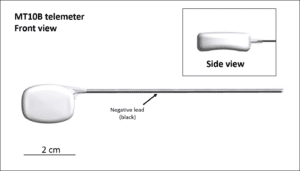Kaha Sciences single-use mouse biopotential telemeters are designed for subcutaneous implantation in mice weighing at least 22 grams. The mouse biopotential telemeters have 8 cm long bipolar electrodes made from high quality coiled stainless steel encased in polyurethane tubing. These lead wires are suitable for measurement of biological electric potential signals.

For ease of identification, the negative lead is coloured black while the positive lead is transparent.
Preparing for surgery
Before you start surgery, make sure you have configured your telemeter and tBase to one of the 40 data collection Channels (Ch 1-40) as all items are shipped on the “Setup” Channel.As with all chronic studies, appropriate analgesia and a post-surgery pain management plan is essential. We also recommend the use of a prophylactic antibiotic. Please consult with your local veterinarian and ethics board regarding this.The video below shows our method for preparing a mouse for surgery to record ECG.
Handling of lead wires during surgery
To reduce noise in the recorded signal, it is recommended that the electrode leads be trimmed to length at the time of surgery rather than coiling any excess wire. It is important, however, to allow some extra length in the electrode leads to allow for animal movement.After trimming the electrode leads to the desired length, it will be necessary to expose the coiled stainless steel electrode within the lead tubing. Care must be taken to avoid damaging the wire as this can lead to wire breakages and poor signal quality during recordings. The recommended way to expose the electrode wire is to use a surgical microscope and carefully trim the tubing from around the wire. Do not trim, stretch or disturb the wire coil within 2.5 cm of the telemeter body.

The stainless steel electrodes are coiled for maximum strength and flexibility. The coil can slip out of a suture, so it may be useful to carefully stretch the coils at the tip of the electrode to allow a suture thread to pass between the coils.
Surgery for recording ECG in the modified lead II position
The video below shows a method for recording ECG in the modified lead II position. We have found that this method, especially the use of surgical mesh and tissue glue, helps secure the biopotential lead wires in place for chronic implantation (60 days). The modified lead II position minimizes the presence of EMG on the ECG signal during animal movement and gives a sizable R-wave for automated heart rate analysis using data analysis software. This lead configuration may not be suitable for all users depending on the information they would like to acquire from the ECG waveform.
Videos contain content hosted by Millar prior to the formation of Kaha Sciences. Kaha Sciences is an ADInstruments brand. Any contact details provided in videos are now out of date - For all product information or support, please contact us.